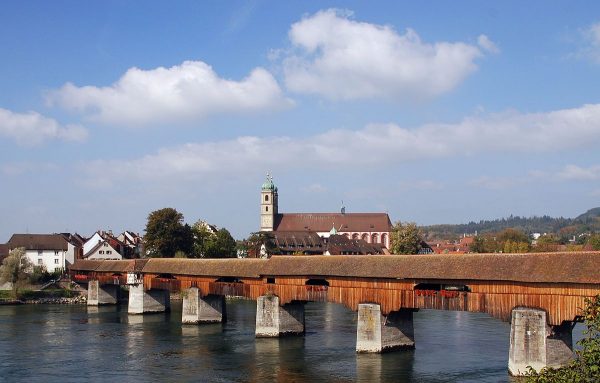Self Sabotage: The Swiss History of Rigging Vital Infrastructure to Explode
Jagged concrete protrusions span for miles along the Swiss Alps. They have been cheerily dubbed “Toblerone Lines” after the famous Swiss chocolate maker, but they have other names, too. More ominous monikers like “dragon teeth” may better fit their original function: to repel invading tanks and other vehicles in wartime. These lines represent some of the most visible elements of defensive infrastructure in a nation known for its perpetual neutrality — a position reinforced by the fact that the country is well-prepared for attacks. Switzerland’s military-trained citizens are armed to the proverbial teeth. Many Swiss defensive strategies, though, are far less visible than spiked ridges and openly carried weapons, including infrastructure carefully designed and built to self-destruct on demand.
Burning Bridges
Reports in 2014 that explosives had finally been removed from a bridge on the Swiss-German border came as a surprise to some — mostly those who hadn’t realized it had been wired to blow in the first place. The Säckinger Bridge was built over the Rhine in 1272 and has long been considered a national monument, but that didn’t stop the government from rigging it with TNT during the Cold War. Military actions like this were part of a larger Swiss defense strategy, which included withdrawing to the mountains and fighting a guerrilla war if invaded. The idea was to leave rubble rather than functional infrastructure behind. These days, the Swiss military won’t comment on whether other infrastructure is still rigged for reasons of military security. Either way, this bridge set up to be demolished on demand is only one example of a longstanding national approach.
In the 1980s, Pulitzer Prize-winning journalist John McPhee wrote a book on the role of the Swiss Army in the country’s cultural and physical landscape. He naturally covered the well-publicized practice of universal military service requirements. In La Place de la Concorde Suisse, though, he also described in detail how the built and natural environments of this small European nation were carefully and extensively weaponized. Bridges were not only designed to be blown up to deter invading forces but were also flanked with hidden artillery to foil enemy repair efforts that might follow demolition.
Along the Alps, the insides of mountains were carved out to create bunkers and supply storage spaces while their exterior slopes were rigged to trigger landslides. Railroad and highway tunnels were designed to be destroyed quickly, too. In short: for much of the 20th century, Swiss infrastructural engineers were tasked with a dual mandate — they had to make functional and durable structures but also incorporate methods for rapid demolition into their designs.
McPhee’s experience of the country changed as he learned more and more about this ubiquitous militarization. Traveling through picturesque mountainside landscapes, he began to notice roads that seemed to dead-end into mountainsides, realizing these may have led to the entrances of bunker complexes. Even a single anomalous stone might be a fake, placed to conceal a military installation. By the 1990s, the Department of Defense was in charge of over 30,000 defensive structures and objects, not including the country’s numerous bunkers.
One Nation, Underground
Underground Swiss shelters date back to the late 1800s, but more comprehensive efforts to fortify the country with subterranean spaces started in the late 1930s as the threat of international war loomed large. Indeed, extensive Swiss military preparations coupled with the daunting topography of the Alps presumably deterred Axis invaders threatening the country on all sides during World War II — would-be attackers feared an endless guerrilla war. Heading into the Cold War, the Swiss continued to expand national defenses, including bunkers.
Switzerland would eventually build out enough bunker space to house the country’s entire population with room to spare — with a buffer of over 10%, no other country’s shelter capacity comes close. The government’s argument for this was that safety from nuclear attack was every citizen’s right. “Every inhabitant must have a protected place that can be reached quickly from his place of residence,” read the Swiss Federal Law on Civil Protection, and “apartment block owners are required to construct and fit out shelters in all new dwellings.” Residents uninterested in building their own shelters were required to pay for spaces in communal shelters. Some shelters were simple affairs, situated in the basements of churches or hospitals or other community buildings, but others were massive and sophisticated, like a rail tunnel that could be sealed off at each end and then be used to house 20,000 people in a crisis situation.
Vernacular Camouflage

While many of these efforts were hidden below the ground or tucked into the structural supports of everyday infrastructure, vernacular architecture has also played a prominent role in Swiss defense. Across the countryside, many structures that look like quaint barns or traditional homes were designed to house everything from bunkers to anti-aircraft guns, with concealment strategies carefully executed by expert craftspeople. “They went about their job with Swiss precision,” explains reporter Anneke Bokern. “Although the bunkers only had to deceive at a minimum distance of 20 meters … they painted realistic window shutters, created perfect imitations of wood grain, and even took the position of the sun into consideration” for adding shadows.
Media attention and books like Christian Schwager’s Fake Chalets have helped make these buildings more of an open secret in recent years, in turn drumming up interest in preserving many of these facilities that no longer serve an official purpose. Over the last few decades, many military structures above ground and below have been declassified and sold off for reuse as homes, data centers, even cheese factories. Visitors can tour some facilities and sleep in others, glimpsing cultural artifacts long hidden below the ground and behind facades.
from Hacker News https://ift.tt/2qba8Ni


